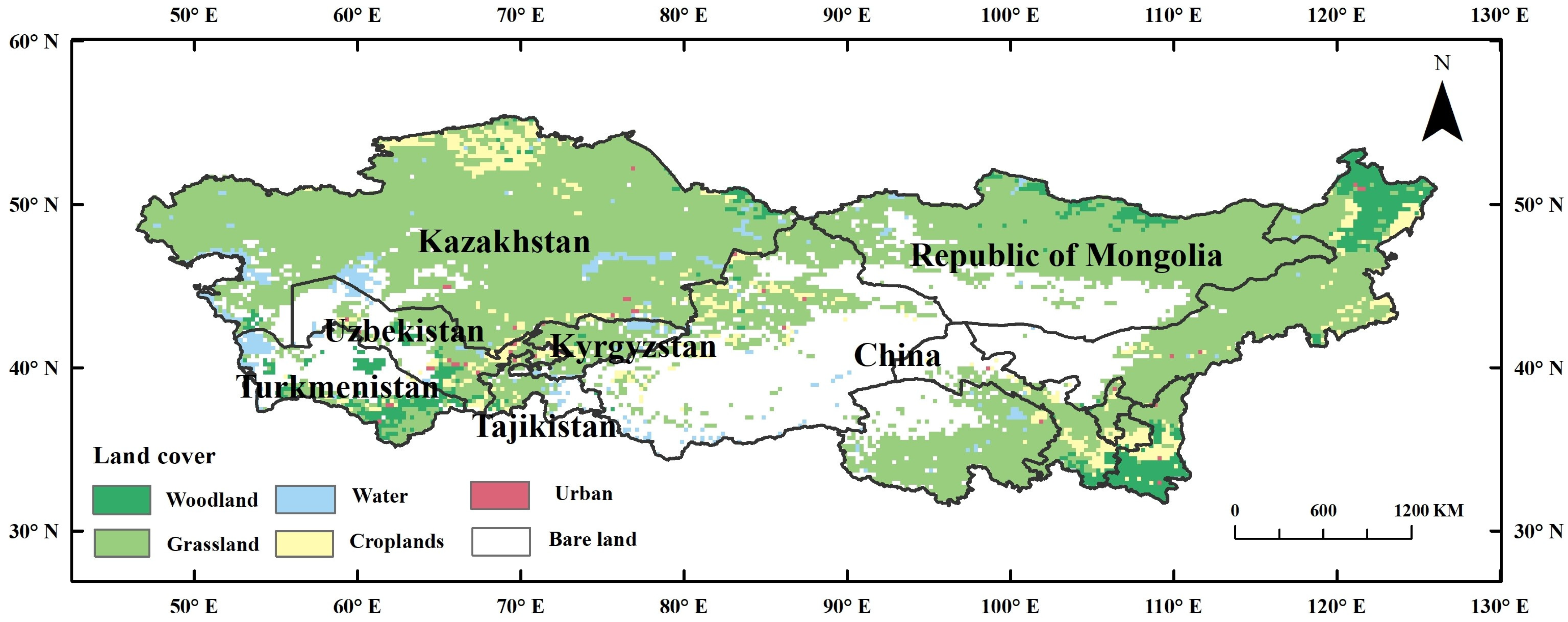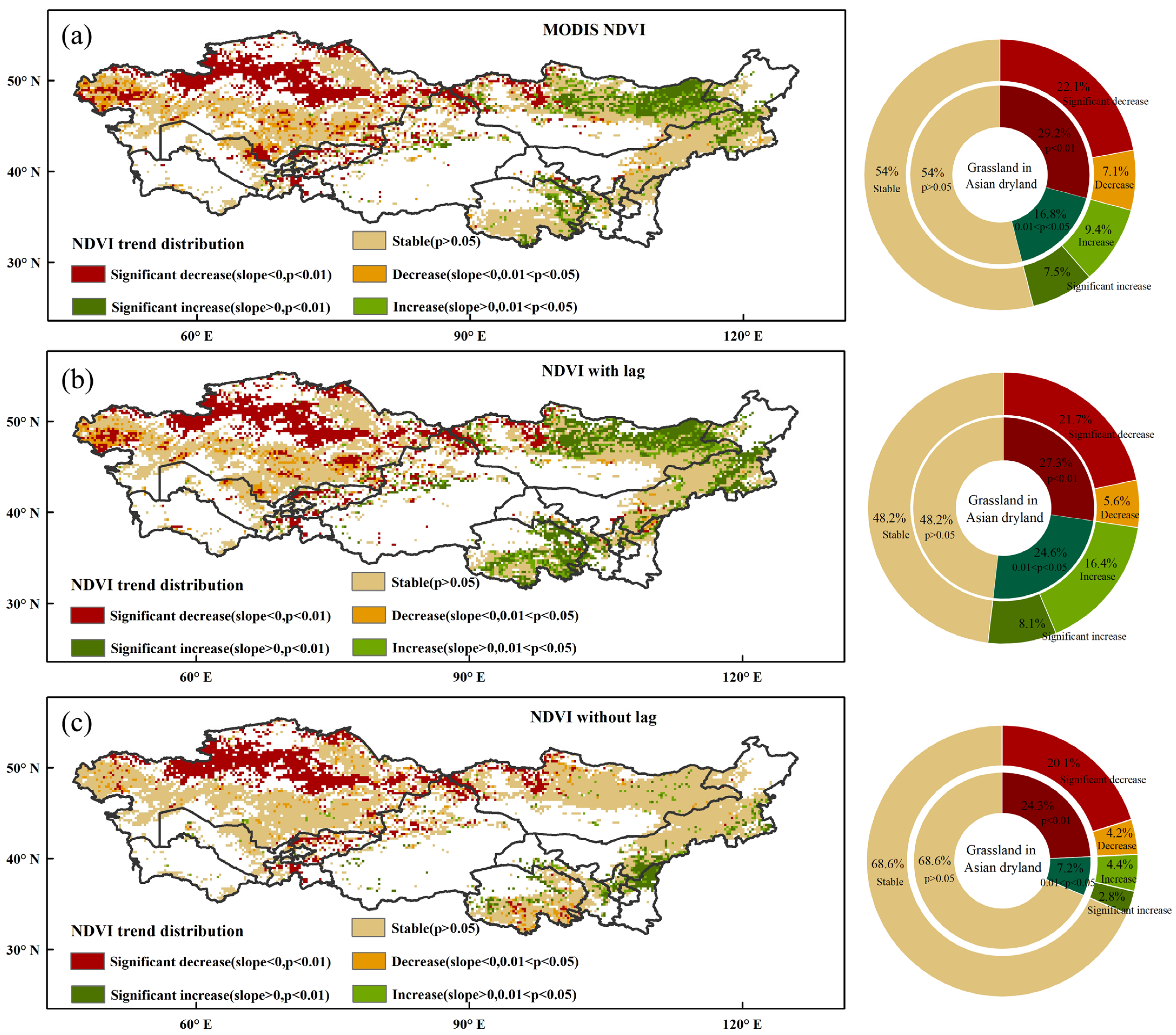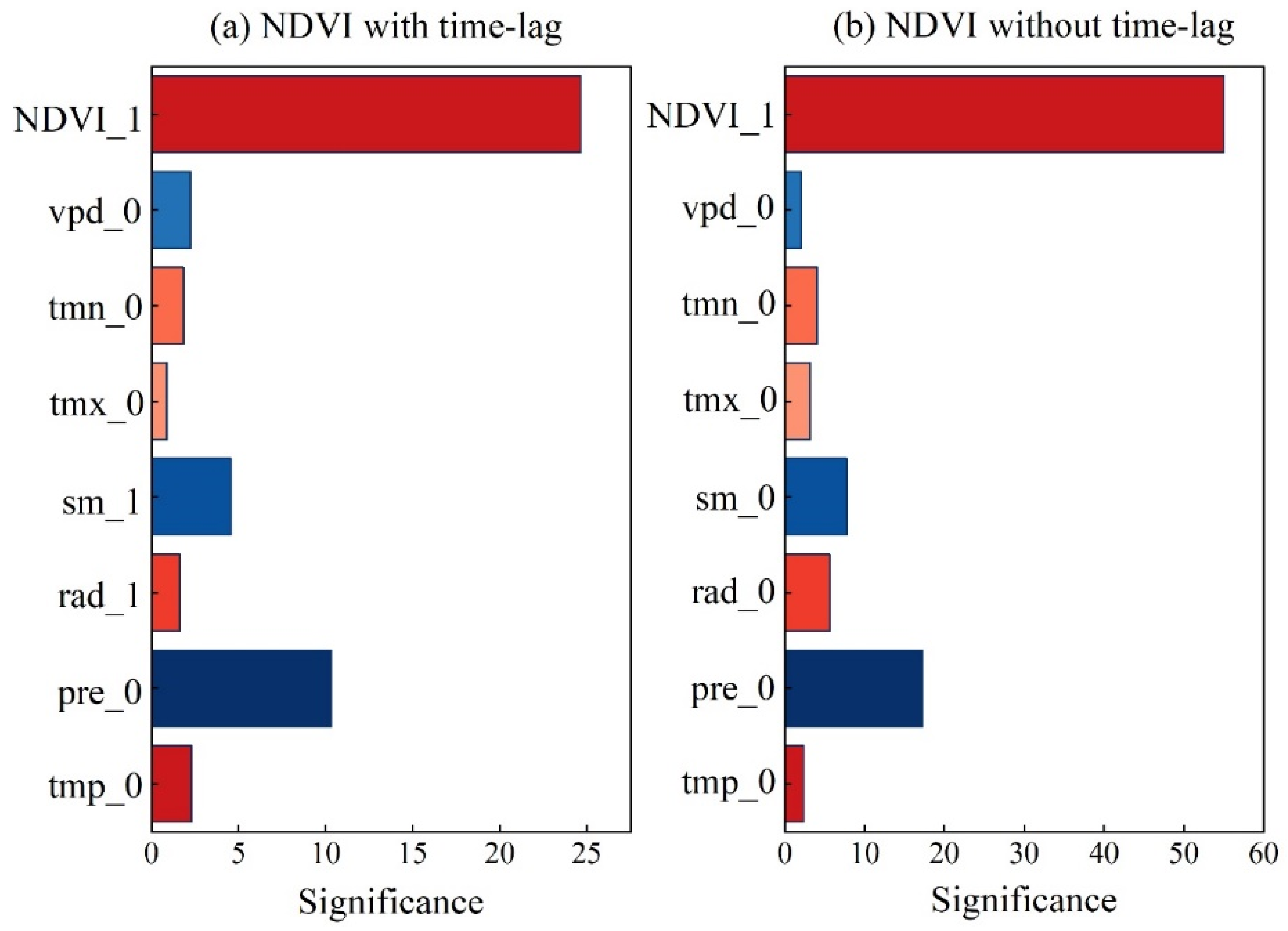Modeling with Hysteresis Better Captures Grassland Growth in Asian Drylands
Abstract
1. Introduction
2. Materials and Methods
2.1. Study Area
2.2. Data Resources
2.2.1. MODIS NDVI
2.2.2. Climate Dataset
2.2.3. Soil Moisture
2.2.4. Land Use Data
2.3. Method
2.3.1. Trend Analyses
2.3.2. Random Forest
2.3.3. Statistical Analysis
3. Results
3.1. Evaluation of Model Performance in Predicting Grassland NDVI in Asian Drylands


3.2. Comparing Spatiotemporal Variations between the Two Models
3.3. Comparing NDVI Trend Spatial Distributions between the Two Models
3.4. Importance of the Variables from Random Forest
4. Discussion
5. Conclusions
Author Contributions
Funding
Data Availability Statement
Conflicts of Interest
References
- Chen, C.; Li, G.; Peng, J. Spatio-temporal characteristics of Xinjiang grassland NDVI and its response to climate change from 1981 to 2018. Acta Ecol. Sin. 2023, 43, 1537–1552. [Google Scholar]
- Afuye, G.A.; Kalumba, A.M.; Busayo, E.T.; Orimoloye, I.R. A bibliometric review of vegetation response to climate change. Environ. Sci. Pollut. Res. 2021, 1–13. [Google Scholar] [CrossRef] [PubMed]
- Bonan, G. Climate Change and Terrestrial Ecosystem Modeling; Cambridge University Press: Cambridge, UK, 2019. [Google Scholar]
- Zhang, Q.; Yuan, X.; Chen, X.; LUO, G.; Li, L. Vegetation change and its response to climate change in Central Asia from 1982 to 2012. Chin. J. Plant Ecol. 2016, 40, 13–23. [Google Scholar] [CrossRef]
- Miao, L.; Sun, Z.; Ren, Y.; Schierhorn, F.; Müller, D. Grassland greening on the Mongolian Plateau despite higher grazing intensity. Land Degrad. Dev. 2021, 32, 792–802. [Google Scholar] [CrossRef]
- Geng, Q.; Chen, X.; He, X.; Tian, Z. Vegetation dynamics and its response to climate change and human activities based on different vegetation types in China. Acta Ecol. Sin. 2022, 42, 3557–3568. [Google Scholar]
- Schimel, D.S.; House, J.I.; Hibbard, K.A.; Bousquet, P.; Ciais, P.; Peylin, P.; Braswell, B.H.; Apps, M.J.; Baker, D.; Bondeau, A. Recent patterns and mechanisms of carbon exchange by terrestrial ecosystems. Nature 2001, 414, 169–172. [Google Scholar] [CrossRef]
- Zhang, J.; Yuan, M.; Zhang, J.; HW, L.; Wang, J.; Zhang, X.; Ju, P.; Jiang, H.; Chen, H.; Zhu, Q. Responses of the NDVI of alpine grasslands on the Qinghai-Tibetan Plateau to climate change and human activities over the last 30 years. Acta Ecol. Sin. 2020, 40, 6269–6281. [Google Scholar]
- Liu, Y.Y.; Van Dijk, A.I.; De Jeu, R.A.; Canadell, J.G.; McCabe, M.F.; Evans, J.P.; Wang, G. Recent reversal in loss of global terrestrial biomass. Nat. Clim. Chang. 2015, 5, 470–474. [Google Scholar] [CrossRef]
- Ray, D.; Ramankutty, N.; Mueller, N.; West, P.; Foley, J. Recent patterns of crop yield growth and stagnation. Nat. Commun. 2012, 3, 1293. [Google Scholar] [CrossRef] [PubMed]
- Li, X.; Yuan, W.; Dong, W. A machine learning method for predicting vegetation indices in China. Remote Sens. 2021, 13, 1147. [Google Scholar] [CrossRef]
- Yuan, W.; Zheng, Y.; Piao, S.; Ciais, P.; Lombardozzi, D.; Wang, Y.; Ryu, Y.; Chen, G.; Dong, W.; Hu, Z. Increased atmospheric vapor pressure deficit reduces global vegetation growth. Sci. Adv. 2019, 5, eaax1396. [Google Scholar] [CrossRef]
- Becker-Reshef, I.; Vermote, E.; Lindeman, M.; Justice, C. A generalized regression-based model for forecasting winter wheat yields in Kansas and Ukraine using MODIS data. Remote Sens. Environ. 2010, 114, 1312–1323. [Google Scholar] [CrossRef]
- Friedlingstein, P.; Jones, M.W.; O’sullivan, M.; Andrew, R.M.; Bakker, D.C.; Hauck, J.; Le Quéré, C.; Peters, G.P.; Peters, W.; Pongratz, J. Global carbon budget 2021. Earth Syst. Sci. Data 2022, 14, 1917–2005. [Google Scholar] [CrossRef]
- Li, S.; Yuan, W.; Ciais, P.; Viovy, N.; Ito, A.; Jia, B.; Zhu, D. Benchmark estimates for aboveground litterfall data derived from ecosystem models. Environ. Res. Lett. 2019, 14, 084020. [Google Scholar] [CrossRef]
- Xia, J.; Yuan, W.; Lienert, S.; Joos, F.; Ciais, P.; Viovy, N.; Wang, Y.p.; Wang, X.; Zhang, H.; Chen, Y. Global patterns in net primary production allocation regulated by environmental conditions and forest stand age: A model-data comparison. J. Geophys. Res. Biogeosci. 2019, 124, 2039–2059. [Google Scholar] [CrossRef]
- Jung, N.-C.; Popescu, I.; Kelderman, P.; Solomatine, D.P.; Price, R.K. Application of model trees and other machine learning techniques for algal growth prediction in Yongdam reservoir, Republic of Korea. J. Hydroinform. 2010, 12, 262–274. [Google Scholar] [CrossRef]
- Xia, J.; Ma, M.; Liang, T.; Wu, C.; Yang, Y.; Zhang, L.; Zhang, Y.; Yuan, W. Estimates of grassland biomass and turnover time on the Tibetan Plateau. Environ. Res. Lett. 2018, 13, 014020. [Google Scholar] [CrossRef]
- Peng, Q.; Li, X.; Shen, R.; He, B.; Chen, X.; Peng, Y.; Yuan, W. How well can we predict vegetation growth through the coming growing season? Sci. Remote Sens. 2022, 5, 100043. [Google Scholar] [CrossRef]
- LI, X.; Chen, Y.; Zhang, Y.; Fan, Y.; Zhou, T.; Xie, F. Impact of climate change on desert steppe in northern China. Adv. Earth Sci. 2002, 17, 254. [Google Scholar]
- Yang, S.; Liu, J.; Wang, C.; Zhang, T.; Dong, X.; Liu, Y. Vegetation dynamics influenced by climate change and human activities in the Hanjiang River Basin, central China. Ecol. Indic. 2022, 145, 109586. [Google Scholar] [CrossRef]
- Sneath, D.J.S. State policy and pasture degradation in Inner Asia. Science 1998, 281, 1147–1148. [Google Scholar] [CrossRef]
- Braswell, B.; Schimel, D.S.; Linder, E.; Moore Iii, B. The response of global terrestrial ecosystems to interannual temperature variability. Science 1997, 278, 870–873. [Google Scholar] [CrossRef]
- Wu, D.; Zhao, X.; Liang, S.; Zhou, T.; Huang, K.; Tang, B.; Zhao, W. Time-lag effects of global vegetation responses to climate change. Glob. Chang. Biol. 2015, 21, 3520–3531. [Google Scholar] [CrossRef]
- Miao, L.; Zhang, Y.; Chuai, X.; Bao, G.; He, Y.; Zhu, J. Effects of climatic factors and their time-lag on grassland NDVI in Asian drylands. Chinese Journal of Plant Ecology. Chin. J. Plant Ecol. 2022, 47, 1375. [Google Scholar] [CrossRef]
- Liu, H.; Zhang, A.; Liu, C.; Zhao, Y.; Zhao, A.; Wang, D. Analysis of the time-lag effects of climate factors on grassland productivity in Inner Mongolia. Glob. Ecol. Conserv. 2021, 30, e01751. [Google Scholar] [CrossRef]
- Jin, K.; Wang, F.; Han, J.; Shi, S.; Ding, W. Contribution of climatic change and human activities to vegetation NDVI change over China during 1982–2015. Acta Geogr. Sin. 2020, 75, 961–974. [Google Scholar]
- Hu, R.; Jiang, F.; Wang, Y.; Li, J.; Li, Y.; Abdimijit, A.; Luo, G.; Zhang, J. Arid ecological and geographical conditions in five countries of central Asia. Arid. Zone Res. 2014, 31, 1–12. [Google Scholar]
- Chen, S.; Guo, J.; Guo, Z.; Gao, R.; Shi, Y. Discipline of temporal and spatial variation of annual mean air temperature in arid and semiarid region in northwest China in the recent 46 years. Arid. Land Geogr. 2009, 32, 364–372. [Google Scholar]
- Huang, R.; Xu, L.; Liu, J. Research on spatio-temporal change of temperature in the Northwest Arid Area. Acta Ecol. Sin. 2013, 33, 4078–4089. [Google Scholar] [CrossRef]
- Miao, L.; Jiang, C.; He, B.; Liu, Q.; Zhu, F.; Cui, X. Response of vegetation coverage to climate change in Mongolian Plateau during recent 10 years. Acta Ecol. Sin. 2014, 34, 1295–1301. [Google Scholar]
- Yin, G.; Meng, X.; Wang, H.; Hu, Z.; Sun, Z. Spatial-temporal variation of vegetation and its correlation with climate change in Central Asia during the period of 1982–2012. Acta Ecol. Sin. 2017, 37, 3149–3163. [Google Scholar]
- Pedelty, J.; Devadiga, S.; Masuoka, E.; Brown, M.; Pinzon, J.; Tucker, C.; Vermote, E.; Prince, S.; Nagol, J.; Justice, C. Generating a long-term land data record from the AVHRR and MODIS instruments. In Proceedings of the 2007 IEEE international Geoscience and remote sensing Symposium, Barcelona, Spain, 23–28 July 2007; pp. 1021–1025. [Google Scholar] [CrossRef]
- Tian, S.; Van Dijk, A.; Tregoning, P.; Renzullo, L.J. Forecasting dryland vegetation condition months in advance through satellite data assimilation. Nat. Commun. 2019, 10, 469. [Google Scholar] [CrossRef]
- Zhang, H.; Zhang, X.; Shang, Y.; Kattel, G.; Miao, L. Continuously Vegetation Greening over Inner Mongolia for the Past Three Decades. Remote Sens. 2021, 13, 2446. [Google Scholar] [CrossRef]
- Harris, I.; Jones, P.; Osborn, T. CRU TS4.05: Climatic Research Unit (CRU) Time-Series (TS) Version 4.05 of High-Resolution Gridded Data of Month-by-Month Variation in Climate (Jan. 1901–Dec. 2020); NERC EDS Centre for Environmental Data Analysis, University of East Anglia Climatic Research Unit: Norwich, UK, 2021. [Google Scholar]
- Bartalis, Z.; Wagner, W.; Naeimi, V.; Hasenauer, S.; Scipal, K.; Bonekamp, H.; Figa, J.; Anderson, C. Initial soil moisture retrievals from the METOP-A Advanced Scatterometer (ASCAT). Geophys. Res. Lett. 2007, 34. [Google Scholar] [CrossRef]
- Wagner, W.; Lemoine, G.; Rott, H. A method for estimating soil moisture from ERS scatterometer and soil data. Remote Sens. Environ. 1999, 70, 191–207. [Google Scholar] [CrossRef]
- De Jeu, R.A.; Wagner, W.; Holmes, T.; Dolman, A.; Van De Giesen, N.; Friesen, J. Global soil moisture patterns observed by space borne microwave radiometers and scatterometers. Surv. Geophys. 2008, 29, 399–420. [Google Scholar] [CrossRef]
- Owe, M.; de Jeu, R.; Holmes, T. Multisensor historical climatology of satellite-derived global land surface moisture. J. Geophys. Res. Earth Surf. 2008, 113. [Google Scholar] [CrossRef]
- Yin, L.; Feng, X.; Fu, B.; Chen, Y.; Wang, X.; Tao, F. Irrigation water consumption of irrigated cropland and its dominant factor in China from 1982 to 2015. Adv. Water Resour. 2020, 143, 103661. [Google Scholar] [CrossRef]
- Leo, B. Random Forests. Mach. Learn. 2001, 45, 5–32. [Google Scholar]
- Amit, Y.; Geman, D. Shape quantization and recognition with randomized trees. Neural Comput. 1997, 9, 1545–1588. [Google Scholar] [CrossRef]
- Breiman, L. Randomizing outputs to increase prediction accuracy. Mach. Learn. 2000, 40, 229–242. [Google Scholar] [CrossRef]
- Dong, J.; Lu, H.; Wang, Y.; Ye, T.; Yuan, W. Estimating winter wheat yield based on a light use efficiency model and wheat variety data. ISPRS J. Photogramm. Remote Sens. 2020, 160, 18–32. [Google Scholar] [CrossRef]
- Johnson, M.D.; Hsieh, W.W.; Cannon, A.J.; Davidson, A.; Bédard, F. Crop yield forecasting on the Canadian Prairies by remotely sensed vegetation indices and machine learning methods. Agric. For. Meteorol. 2016, 218, 74–84. [Google Scholar] [CrossRef]
- Chen, T.; de Jeu, R.; Liu, Y.; van der Werf, G.; Dolman, A. Using satellite based soil moisture to quantify the water driven variability in NDVI: A case study over mainland Australia. Remote Sens. Environ. 2014, 140, 330–338. [Google Scholar] [CrossRef]
- Cheng, X.; Zhou, Z.; Li, W.; Shangguan, D.; Wang, X.; Zhang, X.; Hao, J.; Lin, Q. Monitoring drought situation and analyzing influencing factors in Central Asia using MODIS data. Trans. Chin. Soc. Agric. Eng. 2022, 38, 128–137. [Google Scholar]
- Zou, X.; Song, D.; Chen, S. Ecological carrying capacity of grasslands and animal husbandry sustainability in Central Asia. J. Resour. Ecol. 2019, 10, 598–604. [Google Scholar]
- Du, J.; Bao, G.; Tong, S.; Huang, X.; Wendurina; Meili; Bao, Y. Variations in vegetation cover and its relationship with climate change and human activities in Mongolia during the period 1982–2015. Acta Pratacult. Sin. 2021, 30, 1–13. [Google Scholar]
- Luo, S.; Liu, H.; Gong, H. Nonlinear trends and spatial pattern analysis of vegetation cover change in China from 1982 to 2018. Acta Ecol. Sin. 2022, 42, 8331–8342. [Google Scholar]
- Dong, Y.; Yan, H.; Du, W.; Hu, Y. Spatio-temporal analysis of grassland carrying capacity in Mongolian Plateau based on supply-consumption relationship. J. Nat. Resour. 2019, 34, 1093–1107. [Google Scholar] [CrossRef]
- Pearson, R.G.; Phillips, S.J.; Loranty, M.M.; Beck, P.S.; Damoulas, T.; Knight, S.J.; Goetz, S.J. Shifts in Arctic vegetation and associated feedbacks under climate change. Nat. Clim. Chang. 2013, 3, 673–677. [Google Scholar] [CrossRef]
- Wang, M.; An, Z.; Wang, S. The Time Lag Effect Improves Prediction of the Effects of Climate Change on Vegetation Growth in Southwest China. Remote Sens. 2022, 14, 5580. [Google Scholar] [CrossRef]
- Wang, T.; Wedin, D.A.; Franz, T.E.; Hiller, J. Effect of vegetation on the temporal stability of soil moisture in grass-stabilized semi-arid sand dunes. J. Hydrol. 2015, 521, 447–459. [Google Scholar] [CrossRef]
- Shi, Y.; Jin, N.; Ma, X.; Wu, B.; He, Q.; Yue, C.; Yu, Q. Attribution of climate and human activities to vegetation change in China using machine learning techniques. Agric. For. Meteorol. 2020, 294, 108246. [Google Scholar] [CrossRef]
- Zhang, R.; Zhao, X.; Zuo, X.; Qu, H.; Degen, A.A.; Luo, Y.; Ma, X.; Chen, M.; Liu, L.; Chen, J. Impacts of Precipitation on Ecosystem Carbon Fluxes in Desert-Grasslands in Inner Mongolia, China. J. Geophys. Res. Atmos. 2019, 124, 1266–1276. [Google Scholar] [CrossRef]
- Zou, H.; Gao, G.; FU, B. The relationship between grassland ecosystem and soil water in arid and semi-arid areas: A review. Acta Ecol. Sin. 2016, 36, 3127–3136. [Google Scholar]
- Zhao, S.; Zhao, X.; Li, Y.; Mao, W.; Wang, N.; Chen, Y.; Lu, J.; Chen, X.; Wang, R.; Yang, X. A review on the driving effect of groundwater depth on the evolution of sandy plant soil systems in arid and semi-arid region. Acta Ecol. Sin. 2022, 42, 9898–9908. [Google Scholar]
- Liu, J.; Gao, Q.; Zhu, Y.; Wang, K. Hydraulic Redistribution: Newly Recognized Small Cycle Within the Soil-Plant-Atmosphere Continuum. Chin. J. Plant Ecol. 2007, 31, 794–803. [Google Scholar]
- Li, X.; Piao, S.; Huntingford, C.; Peñuelas, J.; Yang, H.; Xu, H.; Chen, A.; Friedlingstein, P.; Keenan, T.F.; Sitch, S. Global variations in critical drought thresholds that impact vegetation. Natl. Sci. Rev. 2023, 10, nwad049. [Google Scholar] [CrossRef]
- Sun, M.; Li, X.; Xu, H.; Wang, K.; Anniwaer, N.; Hong, S. Drought thresholds that impact vegetation reveal the divergent responses of vegetation growth to drought across China. Glob. Chang. Biol. 2024, 30, e16998. [Google Scholar] [CrossRef]





| Independent Variable | Dependent Variable | Temporal Resolution | Spatial Resolution | Time Span | Model Parameter | |
|---|---|---|---|---|---|---|
| with time-lag | tmp_0, pre_0, rad_1, sm_1 tmx_0, tmn_0, vpd_0, NDVI_1 | NDVI | One month | 0.25° | January 2001–December 2020 | 70% training set, 30% validation set |
| without time-lag | tmp_0, pre_0, rad_0, sm_0 tmx_0, tmn_0, vpd_0, NDVI_1 | NDVI | One month | 0.25° | January 2001–December 2020 | 70% training set, 30% validation set |
Disclaimer/Publisher’s Note: The statements, opinions and data contained in all publications are solely those of the individual author(s) and contributor(s) and not of MDPI and/or the editor(s). MDPI and/or the editor(s) disclaim responsibility for any injury to people or property resulting from any ideas, methods, instructions or products referred to in the content. |
© 2024 by the authors. Licensee MDPI, Basel, Switzerland. This article is an open access article distributed under the terms and conditions of the Creative Commons Attribution (CC BY) license (https://creativecommons.org/licenses/by/4.0/).
Share and Cite
Miao, L.; Zhang, Y.; Agathokleous, E.; Bao, G.; Zhu, Z.; Liu, Q. Modeling with Hysteresis Better Captures Grassland Growth in Asian Drylands. Remote Sens. 2024, 16, 1838. https://doi.org/10.3390/rs16111838
Miao L, Zhang Y, Agathokleous E, Bao G, Zhu Z, Liu Q. Modeling with Hysteresis Better Captures Grassland Growth in Asian Drylands. Remote Sensing. 2024; 16(11):1838. https://doi.org/10.3390/rs16111838
Chicago/Turabian StyleMiao, Lijuan, Yuyang Zhang, Evgenios Agathokleous, Gang Bao, Ziyu Zhu, and Qiang Liu. 2024. "Modeling with Hysteresis Better Captures Grassland Growth in Asian Drylands" Remote Sensing 16, no. 11: 1838. https://doi.org/10.3390/rs16111838
APA StyleMiao, L., Zhang, Y., Agathokleous, E., Bao, G., Zhu, Z., & Liu, Q. (2024). Modeling with Hysteresis Better Captures Grassland Growth in Asian Drylands. Remote Sensing, 16(11), 1838. https://doi.org/10.3390/rs16111838








